| |
|||
|
Four artists worked on the book. They were the so-called Alexis Master who painted the miniatures and the illustrations in the Alexis quire, and three lesser painters who produced the psalter initials, the calendar illustrations and the final diptych of St Alban and David.
|
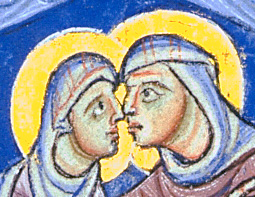 Image
© Hildesheim, St Godehard
|
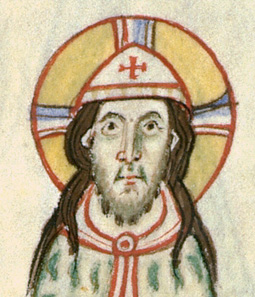
Image © Hildesheim, St Godehard
|
Alexis
Master, p20 (facial banding) |
Alexis
Master, p70 (tonal blending) |
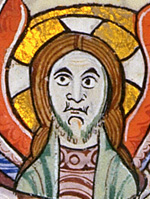
Image © Hildesheim, St Godehard
|
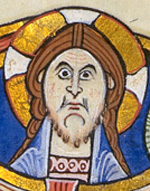
Image © Hildesheim, St Godehard
|
Artist
1, p139 |
Artist
2, p131 |
Another contrasting
pair is pp78 and 94.
P78, by Artist 1, shows his
paler hues, his thin worn blue background, the white face with green jaw
line and ignored under drawing.
P94, by Artist 2, shows the deep saturated colours, firmly applied,
modulated facial shading, and white lacy filigree of highlights on the
drapery.
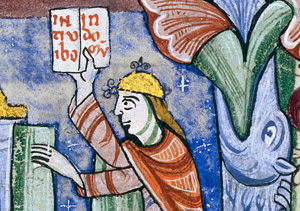 Image
© Hildesheim, St Godehard
|
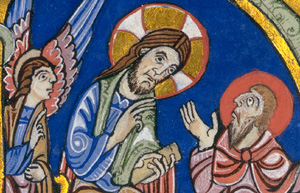
Image © Hildesheim, St Godehard
|
P119 is important because it shows Artist 1 working with lighter tones and washes, a key link to his painting of the Calendar section (Gemini, p7).
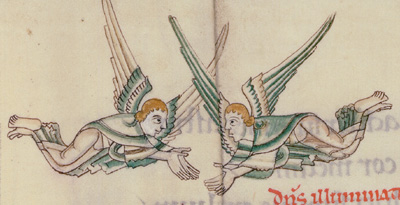 Image
© Hildesheim, St Godehard
|
|
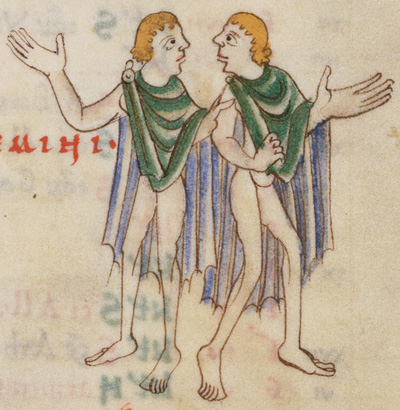 Image © Hildesheim, St Godehard |
The two artists do not always maintain the clearly polarised differences illustrated above. Later on in the book they appear to be working faster or at least spend less time firming up the details of their style, so the differences are less pronounced. For instance, Artist 1 may just fill in a few white lines across the face rather than block it out (p 288, 164). P339 shows Artist 1’s order of work. He has completed all the drapery to a high state of surface decoration but left the face and hair roughly blocked out and unfinished. Artist 2 may ignore his white filigree highlights on the drapery although he still maintains his modelled skin tones. He also left some pictures rather hastily (pp 117, 343,364) with facial details only roughly indicated.
In the Calendar section, the figures of Artist 1 are more stately and
demure, no doubt deriving from traditional classical prototypes for the
personifications of the months and the Zodiac. He applies paint with a
lighter touch. His style matures and softens between p417 and p6 (assuming
that the calendar was made later than the psalms).
These new observations about the faces and modelling have led to the revised division of hands suggested below. They do not make a fundamental difference to Dodwell’s analysis of the style and its sources, but they have an effect on the distribution of labour while the book was being made.
This division is followed by Thomson (1982,120) and Haney (2002,33).
| Pages |
Quire |
?Alexis Master, Artist1, Artist 2, Artist 3 |
| 1-16 |
1 Calendar |
3,4,5,6,7,8,9,10,11,12,13,14 |
| 17-32 |
2 ?Miniatures |
17,18,19,20,21,22,23,24,25,26,27,28,29,30,31,32 |
| 33-52 |
3 |
33,34,35,36,37,38,39,40,41,42,43,44,45,46,47,48,49,50,51,52, |
| 53-56 |
4 Alexis |
53, 54,55,56, |
| 57-72 |
5 |
57, 70,71,72 |
| 73-92 |
6 Psalms |
73,74,76,77,78,80,81,83,84,86,89,90,91,92 |
| 93-112 |
7 |
94,95,96,98,101,104,106, 107,108,109,112 |
| 113-132 |
8 8 |
113,115,117,119,121,123,124, 126,129,131 |
| 133-152 |
9 |
133,135, 139,140, 143, 145,146,147, 149, 152 |
| 153-172 |
10? 10 |
154,156,157,160, 162,163,164, 166, 168, 171 |
| 173-192 |
11 |
173, 175,176,177, 180,181, 183,184, 186,188,189,190,192 |
| 193-212 |
12 |
195,197,198, 200, 202,204,207,210, |
| 213-232 |
13 |
213,216,218,220,221,223, 227, 231 |
| 233-252 |
14 |
233,235,237,238, 240, 242,243, 245,246,248, 250 |
| 253-270 |
15 |
254, 256, 258,259,260,261, 263,264, 266,267,268,269,270 |
| 271-290 |
16 16 16 |
?274, 276, 279,280, 282, 285,288, 290 |
| 291-310 |
17 |
292, 294, 296, 299,300, 302,303,304,306,307,308,309 |
| 311-330 |
18 |
312,313,314,315,316,317,318,319,320,321,322, 323,324,325,326,327,328,329,330 |
| 331-350 |
19 |
331,332,333,334,335,336,337,338,339,340,341,342, 343, 345,346, 348, 350 |
| 351-370 |
20? |
351,352,353, 355, 357,358,359, 361,362, 363,364, 366,367,368,369,370 |
| 371-390 |
21 |
371,372,373, 375, 377, 379, 383, 387,388,389 |
| 391-410 |
22 |
391, 393,394,395,396,397,398,399, 403, 409 |
| 411-414 |
23 |
411,412,413,414 |
| K?ln leaf |
Recto |
|
| 415-418 |
24 Miniatures |
416,417 |
Dodwell’s division of hands creates fairly consistent blocks of initials for each artist, although they are not tied to individual quires. From this system, it appears that Artist 2 was asked to complete the psalm section after the disruption caused by pasting in p285. It makes the Köln leaf look like an afterthought, whereas the final diptych (pp415-418) showing St Alban and David looks like an appropriate introduction by Artist 1 (who began the psalter section), relegated to the end when new material was added to the book.
| Pages |
Quire |
?Alexis Master, Artist1, Artist 2, Artist 3 |
| 1-16 |
1 Calendar |
3,4,5,6,7,8,9,10,11,12,13,14 |
| 17-32 |
2 Miniaturess |
17,18,19,20,21,22,23,24,25,26,27,28,29,30,31,32 |
| 33-52 |
3 |
33,34,35,36,37,38,39,40,41,42,43,44,45,46,47,48,49,50,51,52, |
| 53-56 |
4 Alexis |
53, 54,55,56, |
| 57-72 |
5 |
57, 70,71,72 |
| 73-92 |
6 Psalms |
73,74,76,77,78,80,81,83,84,86,89,90,91,92 |
| 93-112 |
7 |
94,95,96,98,101,104,106, 107,108,109,112 |
| 113-132 |
8 8 |
113,115,117,119,121,123,124, 126,129,131 |
| 133-152 |
9 |
133,135, 139,140, 143, 145,146,147, 149, 152 |
| 153-172 |
10? 10 |
154,156,157,160, 162,163,164, 166, 168, 171 |
| 173-192 |
11 11 |
173, 175,176,177, 180,181, 183,184, 186,188,189,190,192 |
| 193-212 |
12 |
193,195,197,198, 200, 202,204,207,210, |
| 213-232 |
13 |
213,216,218,220,221,223, 227, 231 |
| 233-252 |
14? 14 |
233,235,237,238, 240, 242,243,245,246,248, 250 |
| 253-270 |
15 |
254, 256, 258,259,260,261, 263,264, 266,267,268,269,270 |
| 271-290 |
16 16 |
?274, 276, 279,280, 282, 285, 288, 290 |
| 291-310 |
17 |
292, 294, 296, 299,300, 302,303,304,306,307,308,309 |
| 311-330 |
18? 18 |
312,313,314,315,316,317,318,319,320,321,322, 323,324,325,326,327,328,329,330 |
| 331-350 |
19? 19 |
331,332,333,334,335,336,337,338,339,340,341,342, 343, 345,346, 348, 350 |
| 351-370 |
20? 20 |
351,352,353, 355, 357,358,359, 361,362,363,364, 366,367,368,369,370 |
| 371-390 |
21 |
371,372,373, 375, 377, 379, 383, 389 |
| 391-410 |
22? 22 |
391, 393,394,395,396,397,398,399, 403,409 |
| 411-414 |
23 |
411,412,413,414 |
| K?ln leaf |
Recto |
|
| 415-418 |
24 Miniatures |
416,417 |
This revised division of hands in the psalter section is based on the stark white and green faces of Artist 1 which crop up intermittently within sections previously attributed to Artist 2. Although Artist 1 mainly worked at the beginning and Artist 2 mainly worked at the end, the production was genuinely a team effort. Page 285 did not cause a hiatus in the production although, as indicated elsewhere, it did cause a change in iconographic emphasis. Moreover, the Köln leaf now appears fully integrated with the other collects.
The wide range of comparative illustrations required for this enquiry is amply presented in Dodwell (AP, 119-205) and Haney (1995, 8-11; 2002, 309-315). In searching for the sources of their style, Dodwell rightly concluded that their work was ‘sufficiently close for them to be treated as one for the purposes of analysis’ (AP,199).
The most immediate source for the style of the psalter initials was the St Albans scriptorium. The Prudentius (BL MS Cotton Titus D.XVI) contains many figures similar to both the initials and the miniatures, and was made in the first quarter of the 12th century. From this workshop style, the artists derive their elongated proportions, dramatic gestures, tightly wrapped costumes and a preference for profiles. However, in their hands the sensitive modelling and profound expressions of the Alexis Master are translated into vibrant patterns. The initials artists have very different artistic backgrounds, training and tastes from the Alexis Master.
Their most obvious feature, the striped angular drapery, is found in northern France: Rouen MS 467,f99; Valenciennes MS 512,f4v; with pleated umbrella folds from the Life of St Omer, St Omer MS 698,f34. Figures with pointing, distorted bodies are found in the Corbie Psalter, Amiens MS 18,f11. However, the acrobatic figures and dramatic gestures are also a feature of Anglo-Saxon painting, found in B.L. Cotton MS.Tib.C.VI, and BL Cotton MS.Claud.B IV.
The style of this initial, painted on its separate patch of parchment, appears more ‘advanced’ chronologically. It represents a stage between the miniatures of the Alexis Master and the Shaftesbury Psalter (BL Lansdowne MS.383) which was probably made in the 1130s. In addition to the softly folded drapery with filigree highlights, this artist draws profile noses with an indented bridge and bumpy tip. This nose profile is also found on the St Albans manuscript Princeton, University Library Garret 73, f1a and the Shaftesbury Psalter (Thomson, 1982,116, pl 120).
The Princeton manuscript, Haimo’s commentary on Isaiah, is written by a St Albans scribe and has a St Albans ex libris. Pächt attributes its three initials simply to a ‘follower of the Alexis Master’ (AP, 168, pl. 156a,c). Ayers more confidently asserts that the artist of the Princeton manuscript was resident at St Albans and added the pasted initial to Psalm 105 after Christina’s death (1974, 215-6). Thomson, rightly in my view, distinguishes two artists in the Princeton manuscript (1982, 116, 33-5). One, who paints the seated Isaiah, f1b, is ‘in the style of the Alexis Master’, while the other who paints the dragon initial, f1b, more closely resembles Winchester work of the ‘Entangled Figures Master’ in Oxford, Bodleian Library, Auct. E inf. 1-2, and the Shaftesbury Psalter, British Library, Lansdowne 383. Close points of comparison between Princeton f1a and Albani Psalm 105 are the spurred foliage, the dented noses and expressive eyes. By contrast, on f1b the eye of seated Isaiah is droopy and formulaic while his hands are schematic and feeble compared with the fluttering and nervous fingers of Psalm 105. It is therefore possible that Artist 3, while familiar with the evolution of the Alexis Master’s style, was a temporary import from Winchester.
Artist 3 may never have seen the psalter itself, because he forms his letter C differently from the others in the book. His C is a single gold band while the others swell with foliage in the bow. By contrast, the adjacent hexameter, also on the patch, was written ‘in house’, by Scribe 1. Both the coloured inks and the handwriting are the same as those on the calendar. Moreover, Scribe 1 added his rubric after the patch was glued in: the mordant green ink of his letters has seeped through onto p286 while the green in the initial itself has not.
If Artists 1, 2 and
3 were working at the same time, or even if the pasted initial was added
at a later date, one might speculate why a different artist was chosen
for this special image of Christina. The patron has clearly created an
aesthetic hierarchy for all the pictures in the book: relatively workaday
craftsmen produce the majority of images dealing with a spiritual eternity
in the psalter section; Artist 1 worked more elegantly in the calendar;
the Alexis Master painted the sublime Life of Christ with its full page
miniatures but the Emmaus scenes which relate to Christina, and the Life
of Alexis are painted with washes. Within this scale of quality and importance,
perhaps Artists 1 and 2 with their schematic faces were simply not adequate
for the living portrait Geoffrey wanted of Christina.
Such a hierarchy chosen by the patron can be seen in the Benedictional
of St Aethelwold (B.L.MS Add.49598, f118v). Here an inscription records
that the great Aethelwold ‘commanded that many frames should be
made in this book, which should be adorned and filled with various figures
decorated with numerous colours and with gold’. The Life of Christ
is richly coloured, as is the bishop holding his book. However, to indicate
their different status, the congregation is portrayed in outline only
(Dodwell, 1993,105).
![]()
Go to |
Go to |
| • |
• |
• |
| A
collaboration between History of Art
andHistoric Collections
University of Aberdeen - King's College - Aberdeen - AB24 3SW |
||